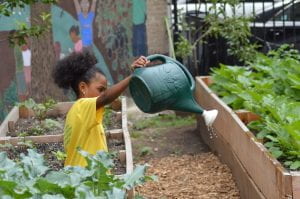What is the first stereotype that comes to mind when you think of Americans? Is it the ongoing obesity epidemic? While there is no denying that the United States has an obesity problem, have you ever stopped and asked why?
For some lower-income families, whether or not their produce is organic or if their poultry has GMOs is the last thing on their minds. As of December 2022, 63% of Americans are living paycheck to paycheck. When more than half of the population is struggling to put food on the table each day, fast food restaurants are the first place they turn. For this reason, poverty is a factor that predisposes Americans to obesity and other health problems such as heart disease and diabetes. On the other hand, there are places like the Bronx where 1 out of every 4 residents goes hungry.
For many Americans, the Slow Food lifestyle sounds nearly impossible to obtain. However, urban agriculture and farm-to-table cooking could actually be the solution to ending the epidemic that is food deserts.
First of all, what is a food desert?

The USDA defines a food desert as an area in which at least 100 households are located more than half a mile from the nearest supermarket and have no vehicle access; or at least 500 people, or 33% of the population, live more than 20 miles from the nearest supermarket, regardless of vehicle availability. More simply put, a food desert is an urban area in which it is difficult to buy affordable or good-quality fresh food. There are currently over 6,500 of these areas in the United States alone.
Residents in these areas are left with little to no options aside from corner stores and fast-food chains with processed foods that are loaded with salt, high fructose corn syrup, and saturated fats. In the United States, since healthcare is not universally available, medical issues that are caused by poor eating often go untreated and could have detrimental effects.
Fortunately, there is hope. Urban Agriculture could be the long-term solution that inner cities need to thrive.

Urban agriculture is farming within crowded cities. While large pieces of land for crops are not available in these settings, the concept is that community members grow crops on their roofs or in nearby plots. The result would be fresh fruits and vegetables being made readily available to the community at no cost.
A spokesperson from the RUAF Foundation stated that “The most striking feature of urban agriculture is that it is integrated into the urban economic and ecological system: urban agriculture is embedded in and interacts with the urban ecosystem. Such linkages include the use of urban residents as laborers, the use of typical urban resources (like organic waste as compost and urban wastewater for irrigation), direct links with urban consumers, direct impacts on urban ecology (positive and negative), being part of the urban food system, competing for land with other urban functions, being influenced by urban policies and plans, etc.”
Not only is growing your own food better for your health and wallet, but it’s better for the environment. It can reduce carbon emissions, decrease the burning of fossil fuels, and eliminate the use of plastic packaging. On top of this, it can unify people and bring communities together to work towards a common goal.
While this may sound out of reach, the movement has already begun. New York-based organizations like The Rise and Root Farm, Project Eats, and Harlem Grown are all hard at work establishing plots and providing clean, healthy ingredients to their community.

When people have the chance to watch their food grow and see where it comes from, it makes eating an enjoyable experience, rather than a necessity we need to survive. Having the ability to cook farm-to-table shouldn’t be a privilege reserved for the wealthy. It’s a memorable experience that every family deserves to have and cherish.
Be sure to follow @PaceDocs on social media as we explore these practices even further and stay tuned for our upcoming documentary For the Love of Food!

